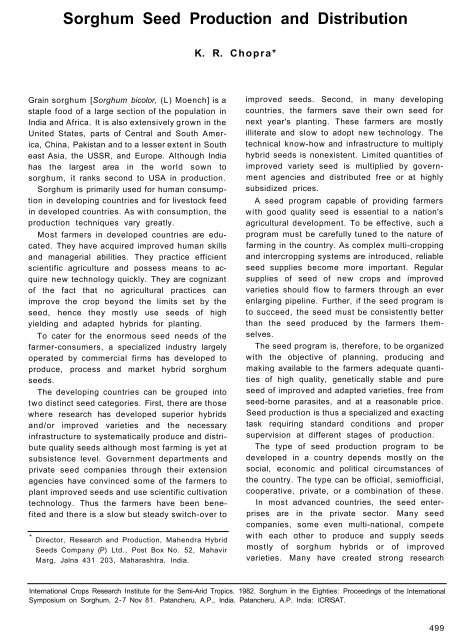RA 00048.pdf - OAR@ICRISAT
RA 00048.pdf - OAR@ICRISAT
RA 00048.pdf - OAR@ICRISAT
Create successful ePaper yourself
Turn your PDF publications into a flip-book with our unique Google optimized e-Paper software.
Sorghum Seed Production and Distribution<br />
K. R. Chopra*<br />
Grain sorghum [Sorghum bicolor, (L) Moench] is a<br />
staple food of a large section of the population in<br />
India and Africa. It is also extensively grown in the<br />
United States, parts of Central and South America,<br />
China, Pakistan and to a lesser extent in South<br />
east Asia, the USSR, and Europe. Although India<br />
has the largest area in the world sown to<br />
sorghum, it ranks second to USA in production.<br />
Sorghum is primarily used for human consumption<br />
in developing countries and for livestock feed<br />
in developed countries. As with consumption, the<br />
production techniques vary greatly.<br />
Most farmers in developed countries are educated.<br />
They have acquired improved human skills<br />
and managerial abilities. They practice efficient<br />
scientific agriculture and possess means to acquire<br />
new technology quickly. They are cognizant<br />
of the fact that no agricultural practices can<br />
improve the crop beyond the limits set by the<br />
seed, hence they mostly use seeds of high<br />
yielding and adapted hybrids for planting.<br />
To cater for the enormous seed needs of the<br />
farmer-consumers, a specialized industry largely<br />
operated by commercial firms has developed to<br />
produce, process and market hybrid sorghum<br />
seeds.<br />
The developing countries can be grouped into<br />
two distinct seed categories. First, there are those<br />
where research has developed superior hybrids<br />
and/or improved varieties and the necessary<br />
infrastructure to systematically produce and distribute<br />
quality seeds although most farming is yet at<br />
subsistence level. Government departments and<br />
private seed companies through their extension<br />
agencies have convinced some of the farmers to<br />
plant improved seeds and use scientific cultivation<br />
technology. Thus the farmers have been benefited<br />
and there is a slow but steady switch-over to<br />
* Director, Research and Production, Mahendra Hybrid<br />
Seeds Company (P) Ltd., Post Box No. 52, Mahavir<br />
Marg, Jalna 431 203, Maharashtra, India.<br />
improved seeds. Second, in many developing<br />
countries, the farmers save their own seed for<br />
next year's planting. These farmers are mostly<br />
illiterate and slow to adopt new technology. The<br />
technical know-how and infrastructure to multiply<br />
hybrid seeds is nonexistent. Limited quantities of<br />
improved variety seed is multiplied by government<br />
agencies and distributed free or at highly<br />
subsidized prices.<br />
A seed program capable of providing farmers<br />
with good quality seed is essential to a nation's<br />
agricultural development. To be effective, such a<br />
program must be carefully tuned to the nature of<br />
farming in the country. As complex multi-cropping<br />
and intercropping systems are introduced, reliable<br />
seed supplies become more important. Regular<br />
supplies of seed of new crops and improved<br />
varieties should flow to farmers through an ever<br />
enlarging pipeline. Further, if the seed program is<br />
to succeed, the seed must be consistently better<br />
than the seed produced by the farmers themselves.<br />
The seed program is, therefore, to be organized<br />
with the objective of planning, producing and<br />
making available to the farmers adequate quantities<br />
of high quality, genetically stable and pure<br />
seed of improved and adapted varieties, free from<br />
seed-borne parasites, and at a reasonable price.<br />
Seed production is thus a specialized and exacting<br />
task requiring standard conditions and proper<br />
supervision at different stages of production.<br />
The type of seed production program to be<br />
developed in a country depends mostly on the<br />
social, economic and political circumstances of<br />
the country. The type can be official, semiofficial,<br />
cooperative, private, or a combination of these.<br />
In most advanced countries, the seed enterprises<br />
are in the private sector. Many seed<br />
companies, some even multi-national, compete<br />
with each other to produce and supply seeds<br />
mostly of sorghum hybrids or of improved<br />
varieties. Many have created strong research<br />
International Crops Research Institute for the Semi-Arid Tropics. 1982. Sorghum in the Eighties: Proceedings of the International<br />
Symposium on Sorghum, 2-7 Nov 81. Patancheru, A.P., India. Patancheru, A.P. India: ICRISAT.<br />
499

















